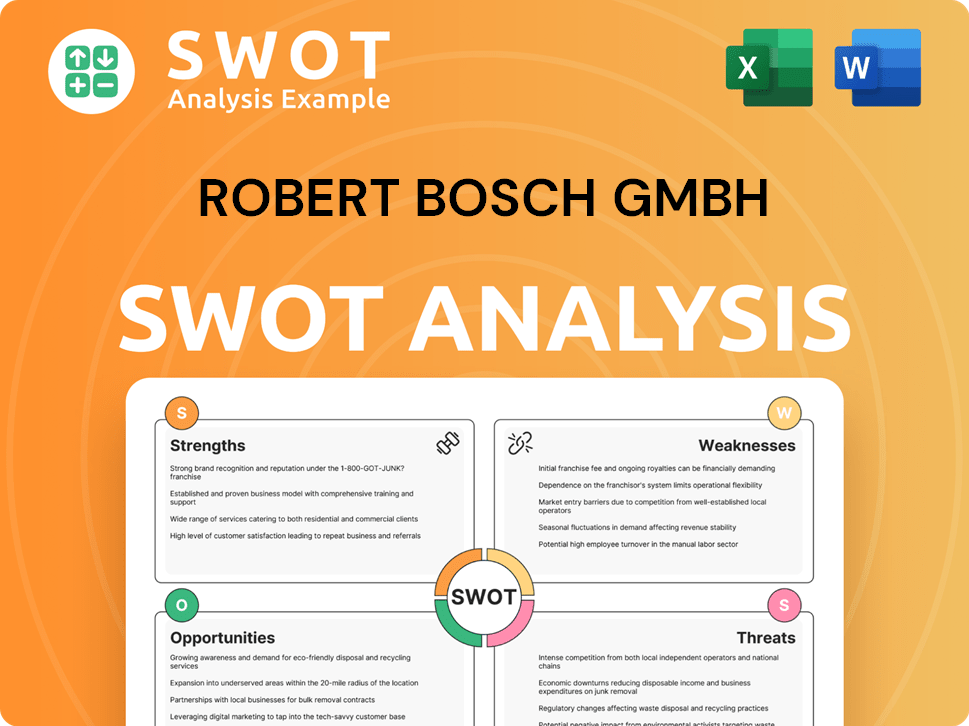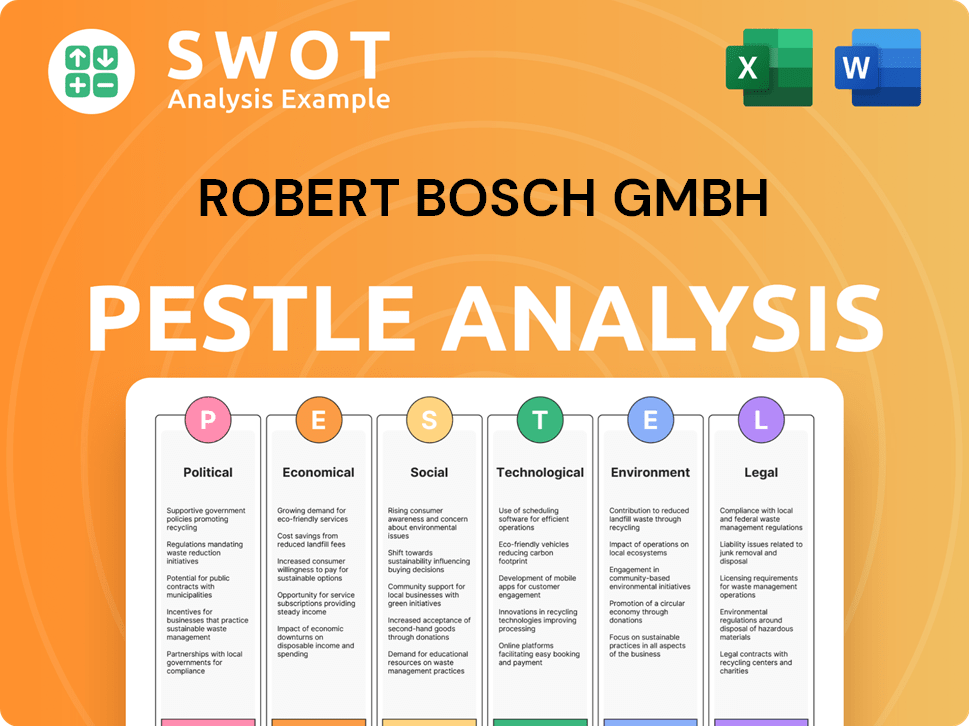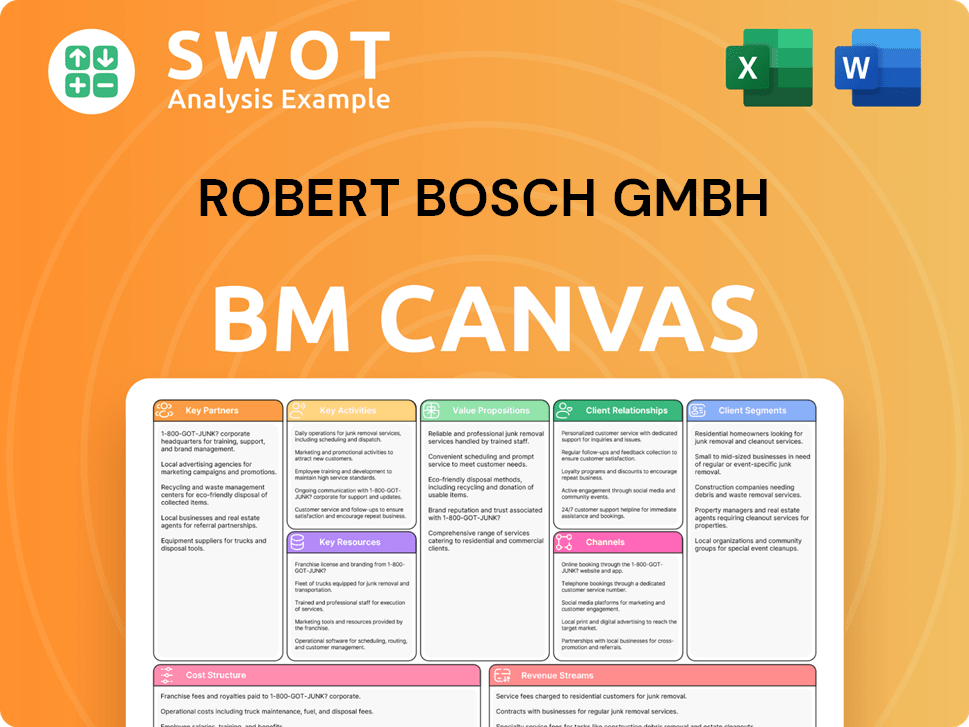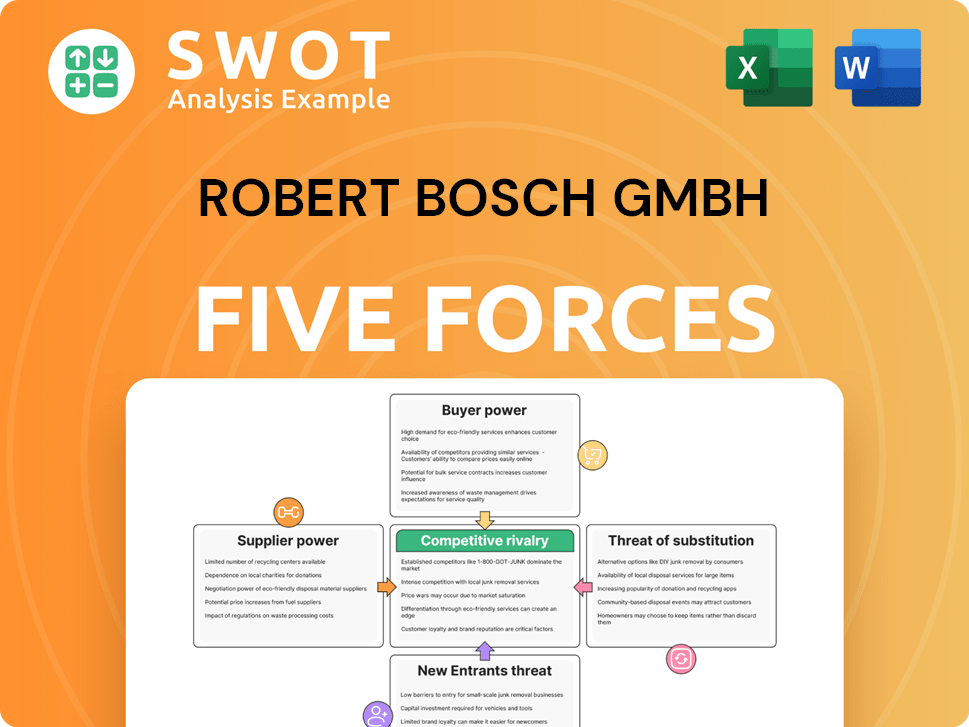Robert Bosch GmbH Bundle
Can Robert Bosch GmbH Maintain Its Technological Edge?
Robert Bosch GmbH, a titan in engineering and technology, is undergoing a significant transformation, fueled by its ambitious Bosch growth strategy. This strategic shift, with a strong focus on software and artificial intelligence, is reshaping its traditional business model. This article delves into Bosch's journey, from its origins to its current position, and explores its plans for the future.

Founded in 1886, the Robert Bosch GmbH SWOT Analysis reveals a company that has consistently adapted to market dynamics. With over 429,000 associates and a revenue of 91.6 billion euros in 2023, Bosch's global market presence is undeniable. This analysis will examine Bosch's strategic initiatives, expansion plans, and its approach to navigating the competitive landscape to understand the Bosch future prospects and its long-term business outlook.
How Is Robert Bosch GmbH Expanding Its Reach?
The expansion initiatives of Robert Bosch GmbH are multifaceted, focusing on geographical reach and product diversification. This strategic approach is particularly evident in high-growth sectors like semiconductors, electromobility, and software-defined mobility solutions. These moves are designed to strengthen its position in key markets and maintain a competitive edge in rapidly evolving industries.
Bosch is actively investing in areas such as electromobility, automated driving, and software-defined mobility. These investments are aimed at addressing the increasing demand for advanced technologies and securing supply chains. The company's expansion strategy is supported by strategic partnerships and a strong focus on sustainable energy solutions, ensuring long-term growth and market relevance.
Bosch's expansion plans include significant investments in its semiconductor business and Mobility Solutions sector. These moves are designed to strengthen its position as a key supplier to the automotive industry's transition to electric vehicles, and to diversify revenue streams. The company's commitment to innovation and strategic partnerships underscores its dedication to future growth and market leadership.
Bosch opened a new wafer fab in Dresden, Germany, in June 2021, representing a significant investment in semiconductor technology. This expansion addresses the growing demand for semiconductors in automotive and IoT applications. The company is also expanding its engineering and manufacturing capabilities for silicon carbide (SiC) power semiconductors.
Bosch is heavily investing in electromobility and automated driving. The company announced plans to acquire TSI Semiconductors in Roseville, California, to convert its fab into a state-of-the-art SiC manufacturing facility in 2024. This strengthens its position as a key supplier to the automotive industry's transition to electric vehicles.
Bosch is expanding its software-defined mobility solutions, aiming to generate 3 billion euros in sales from software by 2030. This includes developing comprehensive software platforms for vehicle computers and connectivity. This strategic move underscores the company's focus on software-driven innovation.
Bosch continues to strengthen its presence in key growth markets, particularly in Asia. The company reported significant sales growth in Asia Pacific (including Africa) in 2023, reaching 28.5 billion euros, demonstrating its commitment to expanding in these regions. This expansion is crucial for long-term growth.
Strategic partnerships play a crucial role in Bosch’s expansion, especially in renewable energy. Collaborations in the hydrogen technology sector, such as the joint venture with Powercell Sweden AB, highlight efforts to diversify into sustainable energy solutions. These initiatives are designed to access new customer segments and diversify revenue streams.
- Joint venture with Powercell Sweden AB for fuel cell stacks.
- Focus on expanding in Asia Pacific, achieving 28.5 billion euros in sales in 2023.
- Aiming for 3 billion euros in software sales by 2030.
- Acquisition of TSI Semiconductors to boost SiC manufacturing.
Robert Bosch GmbH SWOT Analysis
- Complete SWOT Breakdown
- Fully Customizable
- Editable in Excel & Word
- Professional Formatting
- Investor-Ready Format

How Does Robert Bosch GmbH Invest in Innovation?
The core of the Bosch growth strategy is its dedication to innovation and technological leadership. This is supported by significant investments in research and development, driving the company's technological advancements. The company's focus on innovation is essential for maintaining its competitive edge and achieving long-term growth.
Digital transformation and sustainability are also key drivers for the company. By leveraging these areas, the company aims to create new business models and enhance its market position. These strategic initiatives are crucial for adapting to changing market demands and ensuring future success.
The company consistently ranks among the top patent applicants, highlighting its continuous pipeline of new technologies and solutions. This commitment to innovation directly contributes to its growth objectives by creating new revenue streams, improving product performance, and enhancing market competitiveness. For more insights, consider exploring the Target Market of Robert Bosch GmbH.
In 2023, Bosch invested 7.3 billion euros in research and development, accounting for 8.0% of its sales. This significant investment underscores the company's commitment to technological advancement.
Bosch aims to make all its electronic products AI-capable and connectable by 2025. This strategy involves developing its own AI chips and the establishment of the Bosch Center for Artificial Intelligence (BCAI).
Digital transformation is a key driver, with Bosch using automation and data analytics to enhance efficiency. This includes intelligent automation solutions in the Industrial Technology sector.
Bosch is at the forefront of developing advanced driver-assistance systems (ADAS) and solutions for automated driving. These solutions rely heavily on AI and sophisticated sensor technology.
The company invests in technologies for hydrogen production and fuel cell systems. It also develops energy-efficient solutions for buildings and industries, aligning with its sustainability goals.
In 2023, Bosch filed around 4,800 patents worldwide. This demonstrates a continuous pipeline of new technologies and solutions, supporting its Bosch future prospects.
Bosch's innovation strategy focuses on several key areas to drive growth and maintain its competitive edge. These strategies are crucial for its Bosch business development and long-term success.
- Artificial Intelligence (AI) and Internet of Things (IoT): Integrating AI and IoT across all business sectors, with a goal for all electronic products to be AI-capable and connectable by 2025.
- Digital Transformation: Leveraging automation and data analytics to enhance efficiency and create new business models, particularly in Industrial Technology.
- Mobility Solutions: Developing advanced driver-assistance systems (ADAS) and solutions for automated driving, which are heavily reliant on AI and sensor technology.
- Sustainability Initiatives: Investing in technologies for hydrogen production and fuel cell systems, as well as energy-efficient solutions for buildings and industries.
- Research and Development: Continuing substantial investments in R&D, with 7.3 billion euros spent in 2023, representing 8.0% of sales.
Robert Bosch GmbH PESTLE Analysis
- Covers All 6 PESTLE Categories
- No Research Needed – Save Hours of Work
- Built by Experts, Trusted by Consultants
- Instant Download, Ready to Use
- 100% Editable, Fully Customizable

What Is Robert Bosch GmbH’s Growth Forecast?
The financial outlook for Robert Bosch GmbH, a leading player in the automotive and technology sectors, indicates stability and strategic growth. The Bosch company is focused on investing in key areas to ensure long-term success. This approach is crucial for navigating the dynamic global market and capitalizing on emerging opportunities.
For the fiscal year 2023, Robert Bosch GmbH reported total sales of 91.6 billion euros. While this represented a slight decrease of 0.8% compared to the previous year, the figure showed a 3.8% increase when adjusted for exchange-rate effects. This demonstrates the company's resilience and its ability to adapt to market fluctuations. The company's strategic initiatives are designed to drive future Bosch growth strategy.
The company achieved an EBIT (earnings before interest and taxes) of 4.6 billion euros in 2023, with an EBIT margin of 5.0%. Looking ahead, Bosch anticipates sales growth between 5% and 7% in 2024, targeting an EBIT margin of at least 7%. This positive outlook reflects confidence in its strategic initiatives, particularly in electromobility, hydrogen technology, and heat pumps. To understand the company's origins, you can read a Brief History of Robert Bosch GmbH.
Bosch is making significant upfront investments in future technologies to secure its long-term growth. A key area of focus is hydrogen technology, with plans to invest around 4 billion euros by 2030. These investments are crucial for maintaining a competitive edge in emerging markets.
The diversified business model of Bosch helps to mitigate risks associated with fluctuations in any single sector. This diversification supports the company's financial performance and ensures stability. The company's strategic approach allows it to navigate global economic uncertainties.
Bosch maintains a robust financial position, with an equity ratio of 46% at the end of 2023. This strong financial foundation supports the company's strategic investments and ensures sustained growth. The company's financial health is a key factor in its Bosch future prospects.
While global economic uncertainties and inflationary pressures present challenges, Bosch's strategic investments are designed to ensure sustained growth and profitability. The company is well-positioned to capitalize on opportunities in areas like electromobility and renewable energy.
Robert Bosch GmbH Business Model Canvas
- Complete 9-Block Business Model Canvas
- Effortlessly Communicate Your Business Strategy
- Investor-Ready BMC Format
- 100% Editable and Customizable
- Clear and Structured Layout

What Risks Could Slow Robert Bosch GmbH’s Growth?
Robert Bosch GmbH faces several risks that could impact its Bosch growth strategy and future plans. These challenges range from competitive pressures to technological disruptions and regulatory changes. Understanding these potential obstacles is crucial for assessing the Bosch future prospects.
The company must navigate a complex environment, including supply chain vulnerabilities and internal resource constraints. Bosch company has demonstrated resilience, but emerging risks like cybersecurity threats and economic downturns add further layers of complexity. A proactive approach to risk management is essential for sustained success.
Intense market competition, particularly in the automotive and consumer goods sectors, is a significant challenge. Rapid technological advancements, especially in areas like AI and advanced materials, require continuous investment in research and development to stay ahead. Furthermore, changes in regulations, such as stricter emissions standards, can increase compliance costs.
Competition is fierce in the automotive and consumer goods sectors. Established players and new entrants constantly vie for market share. The Bosch competitive landscape includes numerous rivals across various business segments.
Rapid technological changes, especially in AI and quantum computing, pose a constant threat. This necessitates substantial R&D investments to remain competitive. Bosch innovation and technology are key to overcoming these challenges.
Stricter emissions standards and data privacy regulations can increase compliance costs. These changes can also alter market dynamics. Bosch market analysis must consider the impact of evolving regulations.
Supply chain disruptions, such as semiconductor shortages, remain a critical risk. Bosch strategic initiatives include diversifying suppliers and increasing in-house production. This helps mitigate supply chain risks.
The availability of skilled labor, particularly in AI and software development, can hinder growth. Addressing these constraints is essential for Bosch business development. The company invests in training and development programs.
Cybersecurity threats and potential economic downturns pose growing risks. Bosch challenges and opportunities include building robust cybersecurity measures and maintaining a diversified global presence. This helps mitigate emerging risks.
Recent global events have highlighted supply chain vulnerabilities, particularly in the semiconductor industry. Bosch expansion plans include strategies to diversify its supplier base and increase in-house production of critical components. Internal resource constraints, such as the availability of skilled labor in specialized fields like AI and software development, could also hinder growth.
Bosch financial performance is directly tied to its ability to manage risks effectively. A comprehensive risk management framework, including diversification of its business portfolio, proactive engagement with regulatory bodies, and strategic scenario planning, is crucial. The company's resilience in overcoming obstacles, such as navigating the COVID-19 pandemic and supply chain disruptions, demonstrates its proactive approach.
Cybersecurity threats are becoming increasingly sophisticated, impacting connected products and digital services. Bosch investment in research and development includes building robust cybersecurity measures. Economic downturns in key markets also pose risks. Bosch global market presence and diversified portfolio are key strategies for mitigating these evolving threats. For more information on Bosch's competitors, see Competitors Landscape of Robert Bosch GmbH.
The Bosch long-term business outlook is influenced by its sustainability goals and strategies. Bosch sustainability goals include investments in renewable energy and electric vehicle technology. The Bosch electric vehicle strategy is a key area of focus. The company aims to achieve carbon neutrality in its operations.
Robert Bosch GmbH Porter's Five Forces Analysis
- Covers All 5 Competitive Forces in Detail
- Structured for Consultants, Students, and Founders
- 100% Editable in Microsoft Word & Excel
- Instant Digital Download – Use Immediately
- Compatible with Mac & PC – Fully Unlocked

Related Blogs
- What are Mission Vision & Core Values of Robert Bosch GmbH Company?
- What is Competitive Landscape of Robert Bosch GmbH Company?
- How Does Robert Bosch GmbH Company Work?
- What is Sales and Marketing Strategy of Robert Bosch GmbH Company?
- What is Brief History of Robert Bosch GmbH Company?
- Who Owns Robert Bosch GmbH Company?
- What is Customer Demographics and Target Market of Robert Bosch GmbH Company?
Disclaimer
All information, articles, and product details provided on this website are for general informational and educational purposes only. We do not claim any ownership over, nor do we intend to infringe upon, any trademarks, copyrights, logos, brand names, or other intellectual property mentioned or depicted on this site. Such intellectual property remains the property of its respective owners, and any references here are made solely for identification or informational purposes, without implying any affiliation, endorsement, or partnership.
We make no representations or warranties, express or implied, regarding the accuracy, completeness, or suitability of any content or products presented. Nothing on this website should be construed as legal, tax, investment, financial, medical, or other professional advice. In addition, no part of this site—including articles or product references—constitutes a solicitation, recommendation, endorsement, advertisement, or offer to buy or sell any securities, franchises, or other financial instruments, particularly in jurisdictions where such activity would be unlawful.
All content is of a general nature and may not address the specific circumstances of any individual or entity. It is not a substitute for professional advice or services. Any actions you take based on the information provided here are strictly at your own risk. You accept full responsibility for any decisions or outcomes arising from your use of this website and agree to release us from any liability in connection with your use of, or reliance upon, the content or products found herein.